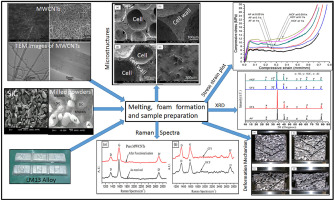当前位置:
X-MOL 学术
›
J. Alloys Compd.
›
论文详情
Our official English website, www.x-mol.net, welcomes your feedback! (Note: you will need to create a separate account there.)
Study on activation energy and strain rate sensitivity of closed-cell aluminium hybrid composite foam
Journal of Alloys and Compounds ( IF 6.2 ) Pub Date : 2020-08-01 , DOI: 10.1016/j.jallcom.2020.154860 B.N. Yadav , Dilip Muchhala , S. Sriram , D.P. Mondal
Journal of Alloys and Compounds ( IF 6.2 ) Pub Date : 2020-08-01 , DOI: 10.1016/j.jallcom.2020.154860 B.N. Yadav , Dilip Muchhala , S. Sriram , D.P. Mondal

|
Abstract High-temperature deformation behavior of LM13 aluminium alloy foam and LM13-silicon carbide (SiC)-multiwall carbon nanotube (MWCNTs) hybrid composite foams (HCFs) was studied and compared with that of LM13-SiC and LM13-MWCNTs composite foams at a temperature range of 25 °C–400 °C and strain rate ranging from 0.001 to 1 s−1. It is noted that the plateau stress and energy absorption decreased with the increasing temperature but increased with increasing the strain rate. Irrespective of kind of foams the combined effect of temperature and strain rate were investigated and the activation energy was determined for each type of foams as a function of temperature and strain rate. The cell walls collapse and microstructural changes during hot deformation were also examined. The hybrid composite foam exhibited the highest plateau stress, modulus, and energy absorption, whereas the alloy foams are softer foam with the lowest plateau stress, modulus, and energy absorption. At temperature 200 °C the deformation is controlled by dynamic recovery and recrystallization.
中文翻译:

闭孔铝混合复合泡沫的活化能和应变速率敏感性研究
摘要 研究了 LM13 铝合金泡沫和 LM13-碳化硅 (SiC)-多壁碳纳米管 (MWCNTs) 混合复合泡沫 (HCFs) 的高温变形行为,并与 LM13-SiC 和 LM13-MWCNTs 复合泡沫的高温变形行为进行了比较。温度范围为 25 °C–400 °C,应变速率范围为 0.001 到 1 s−1。值得注意的是,平台应力和能量吸收随着温度的升高而降低,但随着应变速率的增加而增加。不考虑泡沫的种类,研究了温度和应变速率的综合影响,并确定了每种类型泡沫的活化能作为温度和应变速率的函数。还检查了热变形过程中的细胞壁坍塌和微观结构变化。混合复合泡沫表现出最高的平台应力、模量、和能量吸收,而合金泡沫是较软的泡沫,具有最低的平台应力、模量和能量吸收。在 200 °C 的温度下,变形由动态回复和再结晶控制。
更新日期:2020-08-01
中文翻译:

闭孔铝混合复合泡沫的活化能和应变速率敏感性研究
摘要 研究了 LM13 铝合金泡沫和 LM13-碳化硅 (SiC)-多壁碳纳米管 (MWCNTs) 混合复合泡沫 (HCFs) 的高温变形行为,并与 LM13-SiC 和 LM13-MWCNTs 复合泡沫的高温变形行为进行了比较。温度范围为 25 °C–400 °C,应变速率范围为 0.001 到 1 s−1。值得注意的是,平台应力和能量吸收随着温度的升高而降低,但随着应变速率的增加而增加。不考虑泡沫的种类,研究了温度和应变速率的综合影响,并确定了每种类型泡沫的活化能作为温度和应变速率的函数。还检查了热变形过程中的细胞壁坍塌和微观结构变化。混合复合泡沫表现出最高的平台应力、模量、和能量吸收,而合金泡沫是较软的泡沫,具有最低的平台应力、模量和能量吸收。在 200 °C 的温度下,变形由动态回复和再结晶控制。



























 京公网安备 11010802027423号
京公网安备 11010802027423号